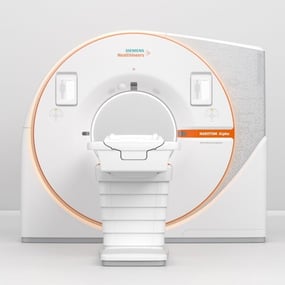 NAEOTOM Alpha opens up a new era of medical imaging
NAEOTOM Alpha opens up a new era of medical imaging
It’s not every day I post a blog talking about a specific Siemens product. But it’s not every day a new technology like photon-counting computed tomography (CT) comes along. In fact, it’s a disruptive technology that comes along perhaps once in a decade. This is a technology that will redefine CT and patient care forever.
Siemens Healthineers recently launched the photon-counting NAEOTOM Alpha CT in a virtual worldwide event and showcased it at the recently concluded 2021 RSNA Annual Meeting.
Computed tomography (CT) is used to perform more than 80 million diagnostic imaging exams in the U.S. every year. And its use continues to grow. More and more it’s being used as a first-line diagnostic tool for conditions like coronary artery disease, in preventive care and in early detection for lung cancer.
But as widespread as it’s becoming, conventional CT still has its limitations—it can’t be used on all patients. For example, CT can’t always be used for patients with medical implants because image artifacts can limit diagnostic accuracy. It also has limitations in image reproducibility and standardization, both of which are crucial for evaluating a disease’s progress. We also need functional data to accompany the anatomical CT images.
Those very shortcomings were on the minds of researchers at Siemens Healthineers when they began working with a new technology—photon-counting CT. Philipp Fischer, Head of Computed Tomography at Siemens Healthineers recently said, “This was the starting point for our thoughts around NAEOTOM Alpha.” The FDA recently gave its approval to the ground-breaking technology, making it the first major advancement in computed tomography in a decade.
NAEOTOM Alpha represents more than 15 years of research. This new technology provides dramatic improvements in diagnostic imaging, with increased resolution and reduced radiation dose—up to 45 percent more than conventional CT detectors. Its QuantaMax detector provides high-resolution images at minimal dose, spectral information on each scan and better contrast at lower noise.
What makes photon-counting CT technology different?
Computed tomography was itself a revolution when it debuted 50 years ago, in 1971. It provides images of organs and tissues physicians hadn’t been able to see with conventional X-rays.
Conventional CT requires a two-step conversion in order to turn X-ray photons into a medical image. When X-rays hit a scintillator, they create a light signal that is collects from thousands of photons to a single optical signal, which is then converted into an electrical signal with a photodiode. Although it’s reliable and stable, the two-step process limits dose efficiency. And with many photons of different energies making up the optical signal, energy information is lost in the process.
Photon-counting detectors directly transform X-ray photons into electrical signals. The technology uses a single, one-step process that converts X-ray photons into an electrical current to create the image. This increases dose efficiency. The big difference? An ability to assess every single photon separately and measure their energy level.
The new technology required Siemens to create an entirely new detector material: high-purity cadmium telluride (CdTe) crystals. They produce the highest spatial resolution of any CT system to date. The detector pixels are nine times smaller than those used in conventional CT. The crystals enable lower dose requirements due to the higher signal-to-noise ratio from eliminating electronic noise from the detector.
Unlike standard CTs that can underrepresent low-energy photons, photon-counting technology uses all photons equally. This could be especially helpful in soft-tissue imaging. And with NAEOTOM Alpha’s QuantaMax detector’s spectral sensitivity, every scan provides spectral data.
Clinical Implications
Cardiology
Photon-counting technology provides exciting clinical advances. For example, you can ask patients to hold their breath during a scan, but you can’t ask a heart to stop beating. Speed is critical in cardiac imaging, which NAEOTOM Alpha provides thanks to its Dual Source design.
In conventional CT, calcifications or implanted devices, such as stents or pacemakers, can produce image artifacts, which ultimately excludes a critical population of patients. But photon-counting technology increases diagnostic accuracy by revealing differentiation between stents, pacemakers, calcifications and vessel walls and contrast media. Non-invasive imaging becomes available to every patient who could benefit from it.
Oncology
Cancer patients usually face not only diagnostic scanning, but also repeated follow-up assessments in measuring treatment response and disease progression. Conventional CT is limited in providing accurate comparison of scans over time. But photon-counting technology is extremely precise. It produces consistent signal quality for every patient and every scan.
Pulmonology
Multiple images are often required for a meaningful diagnosis of pulmonology disease. With a standard CT, you must know beforehand what you’re looking for to design an imaging exam. You can’t look for every detail in one exam without compromising on patient dose. You also compromise image resolution and functional information. But a single image with photon-counting technology provides structural images and functional information.
And, although photon-counting technology is highly complex, NAEOTOM Alpha removes any complexity for the user by utilizing myExam Companion, which guides operators through every CT scan procedure.
These are just three areas that stand to benefit greatly from the advances of photon-counting technology. The clinical implications are revolutionary for patients and physicians; the higher-quality images of photon-counting CTs will provide better information for making critical healthcare decisions. It could help in nearly every clinical field.








Comments